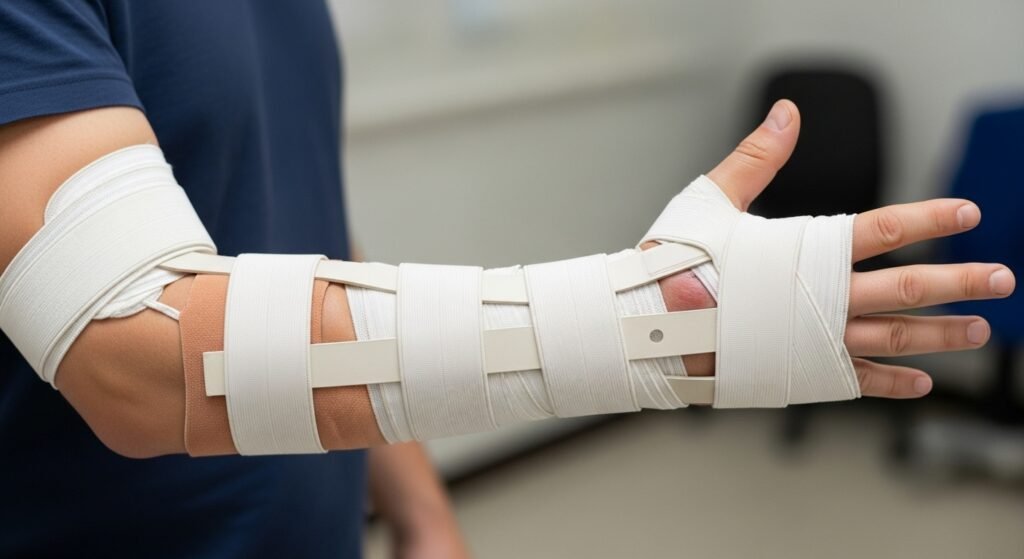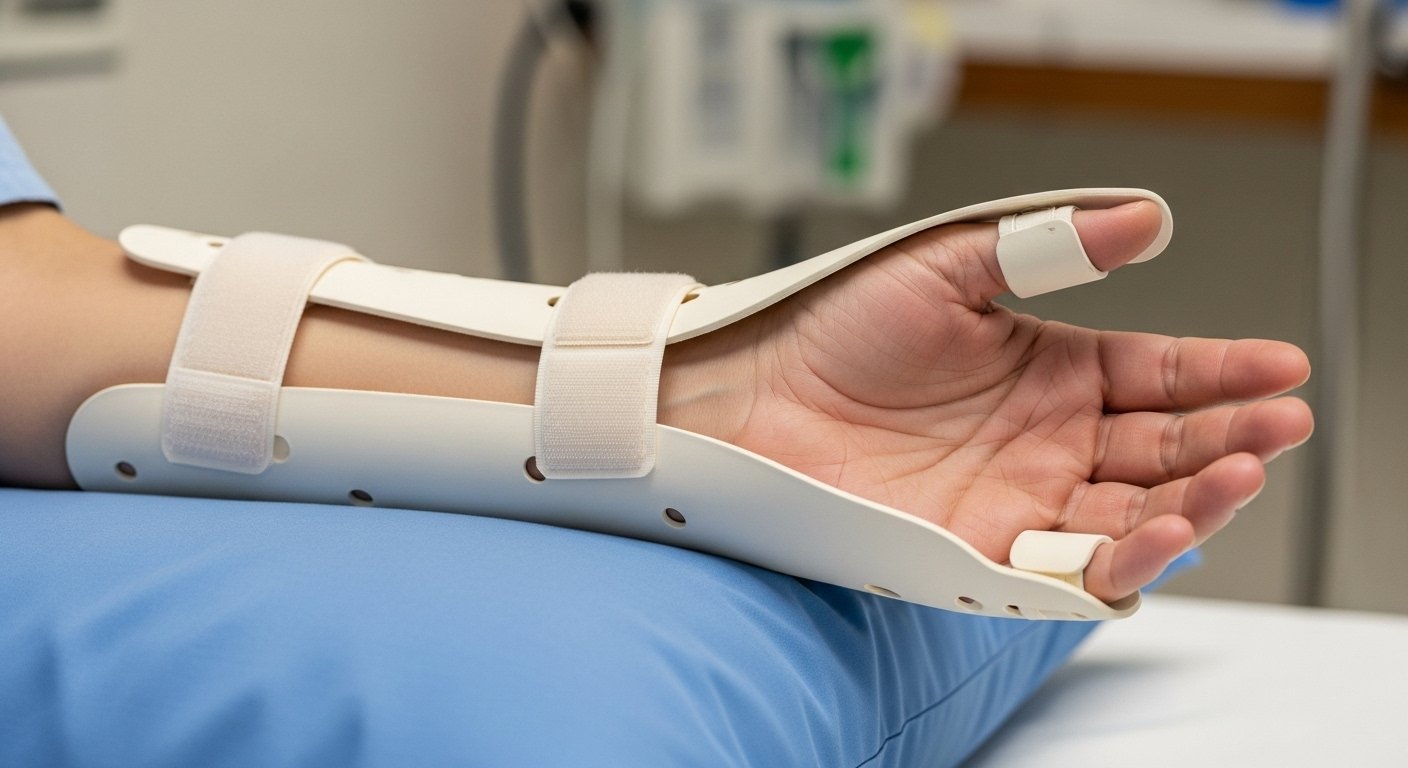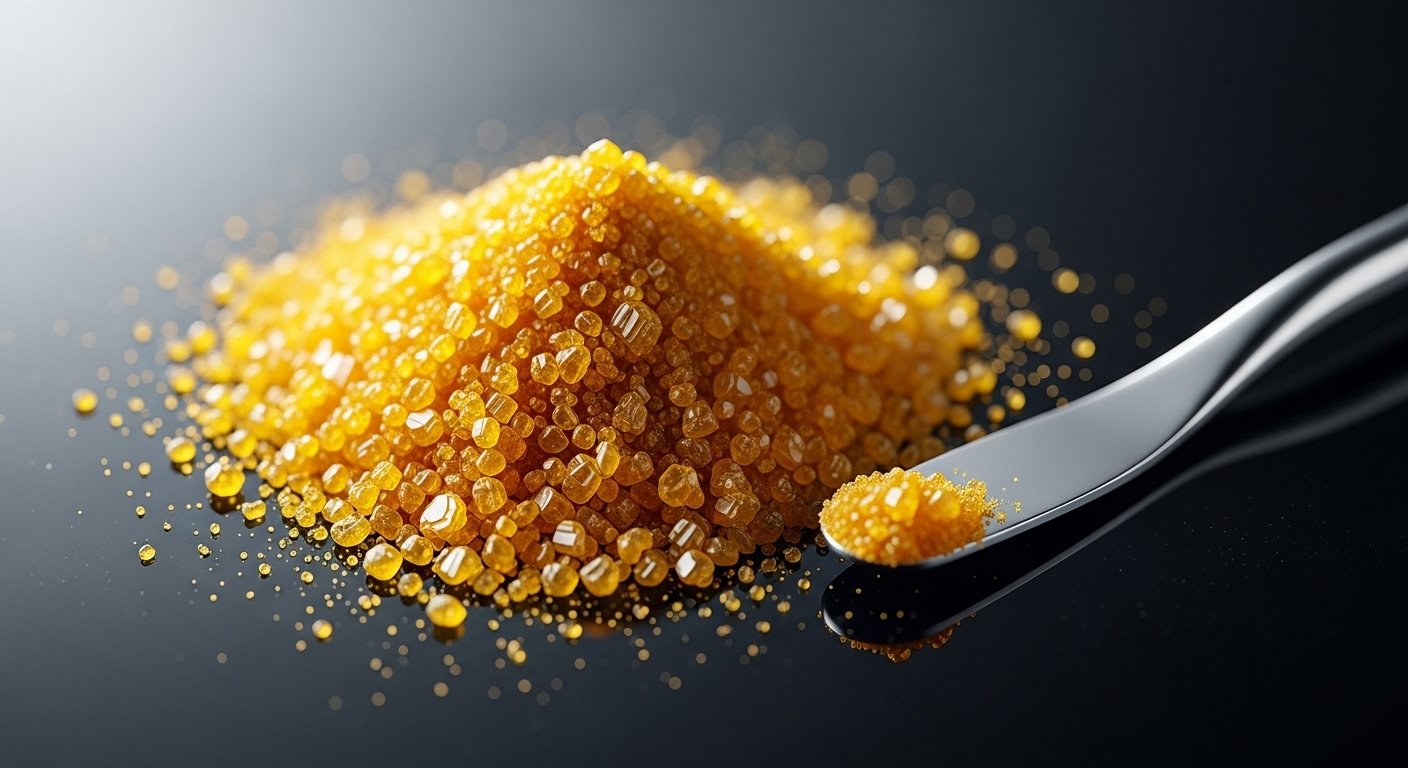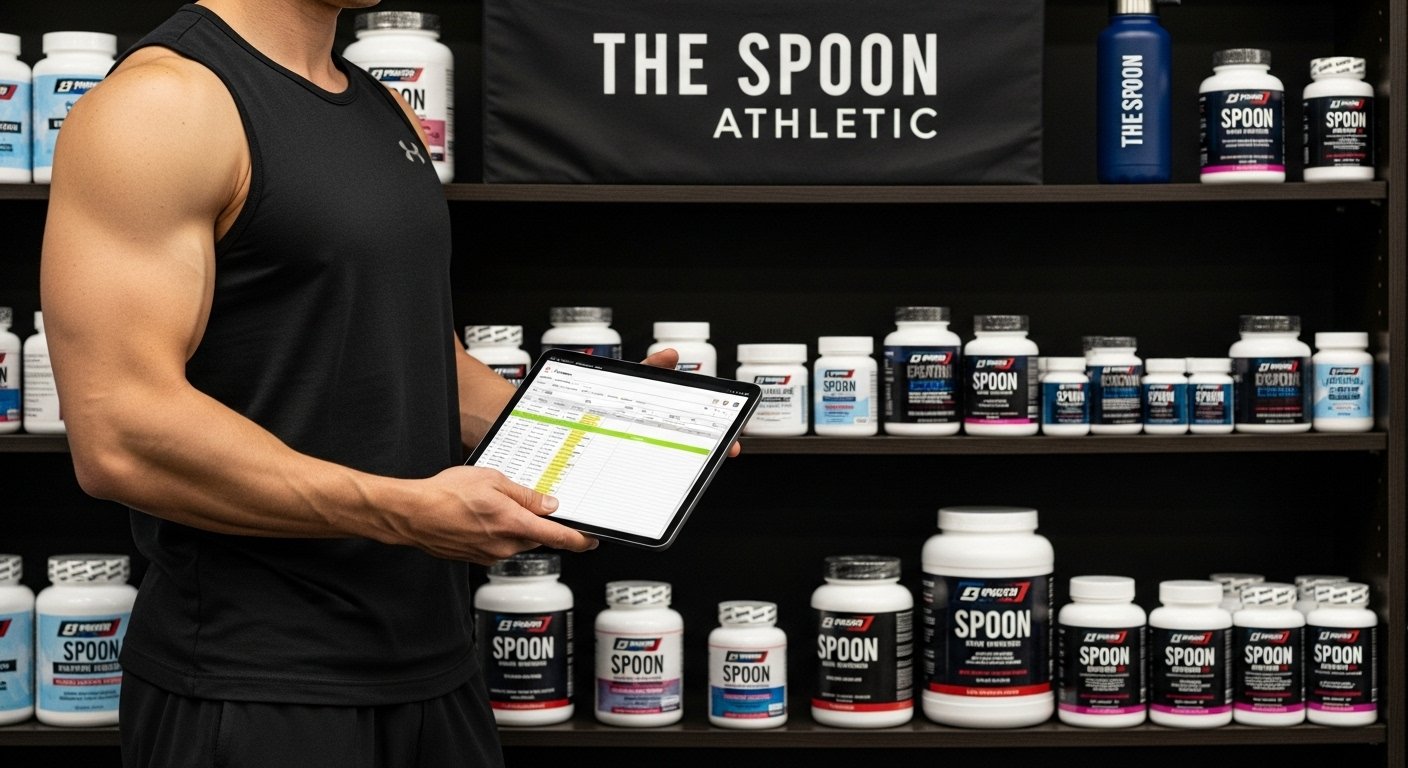Table of Contents
Introduction
If you’ve had an injury on the pinky side of your hand, you might be told you need an ulnar gutter splint. Don’t worry if that term sounds new. It’s just a medical name for a simple tool that helps bones, muscles, and soft tissue heal by keeping part of your hand and arm still.
An ulnar gutter splint is used when you hurt the outer fingers or the side of your hand that includes the common ring and pinky finger bones. A splint like this lets your body heal safely by holding everything in place. It helps reduce pain, swelling, and the risk of long-term problems.
In this easy-to-understand guide, you’ll learn what an ulnar gutter splint is, why doctors use it, how to wear it, and how it helps with healing. We’ll also answer your questions about care, comfort, daily life, and recovery. If you or someone you know is wearing an ulnar gutter splint, this guide is made for you.
What Is an Ulnar Gutter Splint
An ulnar gutter splint is a type of medical brace that covers part of your hand, wrist, and lower arm. It is made to protect the ulnar side of your hand. That’s the outer part closest to your little finger. The splint supports the fourth (ring) and fifth (pinky) fingers.
This type of splint is used when you have a break, dislocation, sprain, or surgery involving those fingers or their bones. The splint keeps the affected area still and safe, giving your body time to heal naturally and correctly.
While it may look like a cast, an ulnar gutter splint has an open side and is often removable. That makes it a little more comfortable and easier to manage when swelling is still present. A doctor or specialist will carefully fit and shape your splint to your hand and arm.
When Do You Need an Ulnar Gutter Splint
You may need an ulnar gutter splint if you have an injury to the pinky side of your hand or wrist. Doctors commonly use it for fractures in the fourth or fifth metacarpal bones. These are the long bones inside your hand that lead to your ring and little fingers.
Other reasons for using an ulnar gutter splint include:
sprains of the small finger’s joints
tendon injuries or dislocations
ligament tears that need rest
minor post-surgery protection
Doctors choose this type of splint when the bones and soft tissues need to stay in one place to heal. It works well because it holds the right part of your hand still while letting other fingers and your thumb stay free.
What an Ulnar Gutter Splint Looks Like
An ulnar gutter splint is a soft- and hard-sided support that wraps around the pinky side of your lower arm and hand. It’s shaped like a shallow “gutter” that cradles your outer hand, wrist, and forearm. That’s where its name comes from.
This splint usually goes from just past your fingertips to a few inches below your elbow. Inside, there’s soft padding to help you feel comfortable. The outside is firm, made from materials like fiberglass, plaster, or thermoplastic. This strong shell protects the injured area.
The ulnar gutter splint keeps your elbow bent at around 90 degrees, your fingers slightly curled, and your wrist in a straight or slightly extended position. Most splints are wrapped with bandages, tape, or Velcro to keep everything secure but not too tight.
How the Ulnar Gutter Splint Helps with Healing
The most important job of an ulnar gutter splint is to keep your injured hand from moving. After a break or sprain, movement can delay healing or even make the injury worse. That’s why your doctor may place you in this type of splint right away.
By keeping your pinky and ring finger still, the splint gives your bones and tissues time to repair. It also lowers swelling, reduces pain, and protects from bumping or re-injury. The splint holds everything in the right position—a step that’s vital when waiting for bones to heal or surgery to recover.
Think of your body like a cut. If you keep bumping an open cut, it doesn’t get better. But if you leave it alone and protect it, the skin closes fast. That’s exactly what the ulnar gutter splint helps your hand do.
How to Wear an Ulnar Gutter Splint Correctly

Once your doctor gives you an ulnar gutter splint, it’s very important to wear it the right way. Never change the shape or fit on your own. These splints are carefully molded to support your injury just right.
Here’s what wearing it should feel like:
snug but not too tight
your fingers in a natural curve
your wrist in a straight line
no tingling, burning, or numb feeling
Always follow your doctor’s directions. Some people need to wear the splint all day and night. Others are allowed to take it off while resting or doing certain exercises. If your splint starts to feel uncomfortable or your fingers change color, call your provider right away.
Caring for Your Ulnar Gutter Splint at Home
Taking care of your ulnar gutter splint helps ensure healing and comfort. Even the best splint won’t help you heal if it’s worn wrong, gets wet, or causes skin problems.
Keep the splint dry at all times. Cover it with a bag or waterproof wrap during showering.
Do not stick objects inside the splint to itch or scratch your skin.
Check your fingers daily. If they turn blue, white, or very cold, call your doctor.
Clean the skin around your splint gently with soap and water.
Keep your arm raised on a pillow to help reduce swelling.
By following these steps, your ulnar gutter splint will stay clean, safe, and effective while your injury heals.
Things You Should and Shouldn’t Do with an Ulnar Gutter Splint
When wearing an ulnar gutter splint, it’s good to know what activities are helpful and which ones you should avoid. Here’s a simple list to guide you:
Do:
keep your arm above your heart when resting
wiggle your free fingers to keep them from getting stiff
follow up with your doctor as scheduled
Do not:
lift heavy objects
allow the splint to get wet
try to remove or adjust it without approval
hit, bump, or bang the injured area
Your splint is a healing tool. Treat it with care, and it will help you return to normal activities faster and safer.
Differences Between an Ulnar Gutter Splint and a Cast
It’s easy to think that an ulnar gutter splint and a cast are the same. But they’re used for different reasons and feel different too.
A cast wraps fully around the arm or foot and is made of firm, hard material. It’s meant for long-term use, often 3–6 weeks, and is not removable.
An ulnar gutter splint does not wrap all the way around. It usually covers one side of the arm. This makes it easier to put on or remove and more flexible in the early stages of healing.
Doctors might choose a splint first before swelling goes down. Later, they might switch you to a cast or soft brace.
How Long You Will Need the Ulnar Gutter Splint
Most people wear an ulnar gutter splint for two to six weeks. The total time depends on how serious the injury is—and whether surgery took place. Some people may begin with a splint and move to a cast or brace later.
It’s important to follow your doctor’s timeline. Don’t take off the splint early, even if you feel better. Bones or tendons that haven’t healed properly can cause long-term problems.
When the splint comes off, you might feel weak or stiff at first. That’s normal. It just means your hand is adjusting again to moving the way it used to.
What to Expect After the Ulnar Gutter Splint Comes Off
Once your doctor says it’s time to stop using the ulnar gutter splint, you may notice a few things. Your hand and fingers may feel sore, and your muscles might feel weaker. Don’t worry. This is normal after not using certain parts of your hand for a few weeks.
To help with recovery, your doctor or therapist may give you finger exercises to improve strength and get back full motion. These movements are simple, but important.
Be patient with your hand. It took time to heal, and it needs more time to regain full strength and flexibility. Most people return to normal activities after a few weeks of gentle use.
FAQs
When should I get an ulnar gutter splint?
Your doctor may use it right after a hand or finger injury involving the pinky and ring fingers.
Can I take the splint off at night?
Only if your doctor says so. Many injuries require full-time wear during healing.
Should the splint feel tight?
It should feel firm, not painful. If it’s too tight or numb, tell your doctor.
Can I shower with it on?
No. Keep the splint dry with a waterproof cover when bathing or washing.
Is it normal that my fingers can’t move?
Yes. The splint holds them still on purpose to protect healing tissues.
Can I return to school or work while wearing a splint?
Often yes, but avoid any heavy lifting or hand use until cleared by a medical professional.
Conclusion
Healing from a hand or finger injury is never fun—but the ulnar gutter splint helps make sure it goes as smoothly as possible. It’s there to protect your bones, ease your pain, and support you through recovery.
By learning what your ulnar gutter splint does and how to take care of it, you take big steps toward healing. Be patient with your body. Rest when needed. Keep the area clean and dry. And always listen to your healthcare provider.
With time, your hand will get strong again. And you’ll be grateful your ulnar gutter splint gave you the recovery boost you needed.




